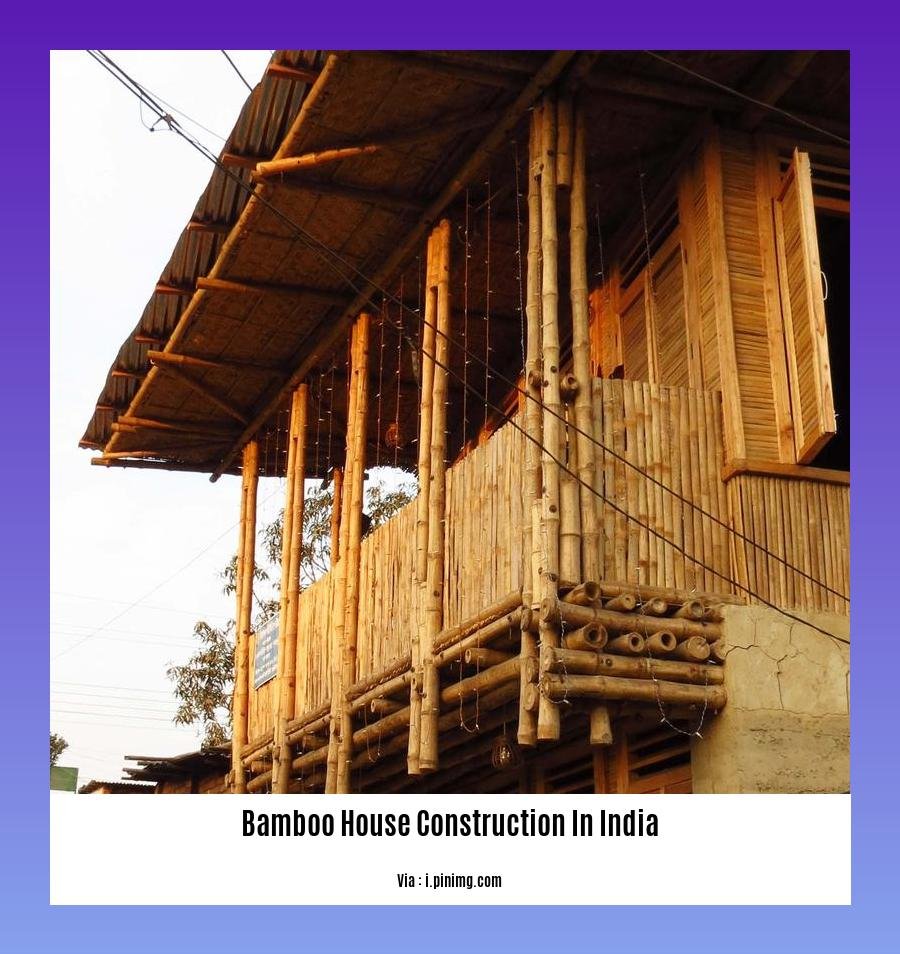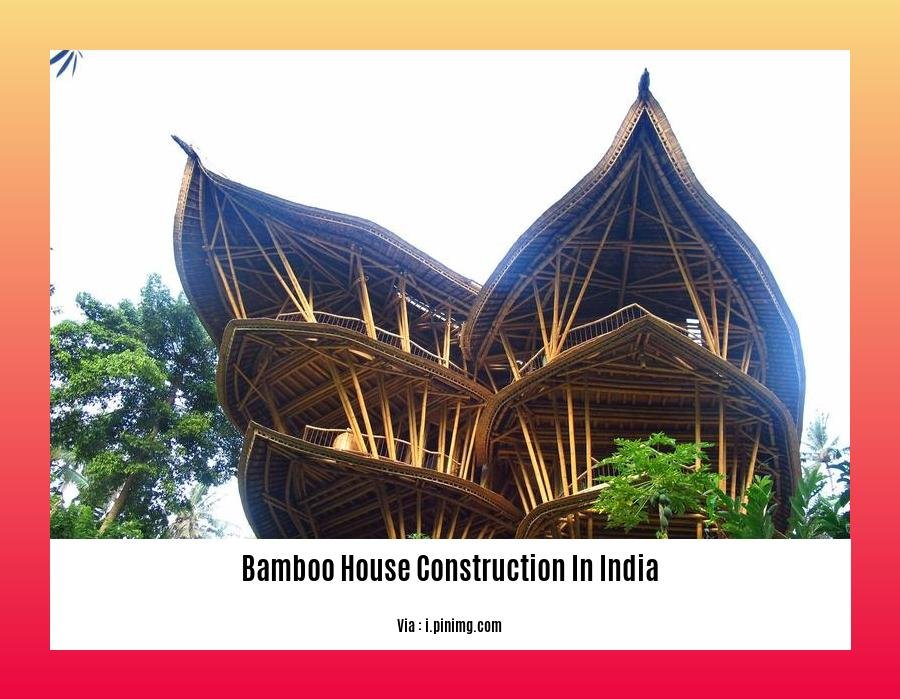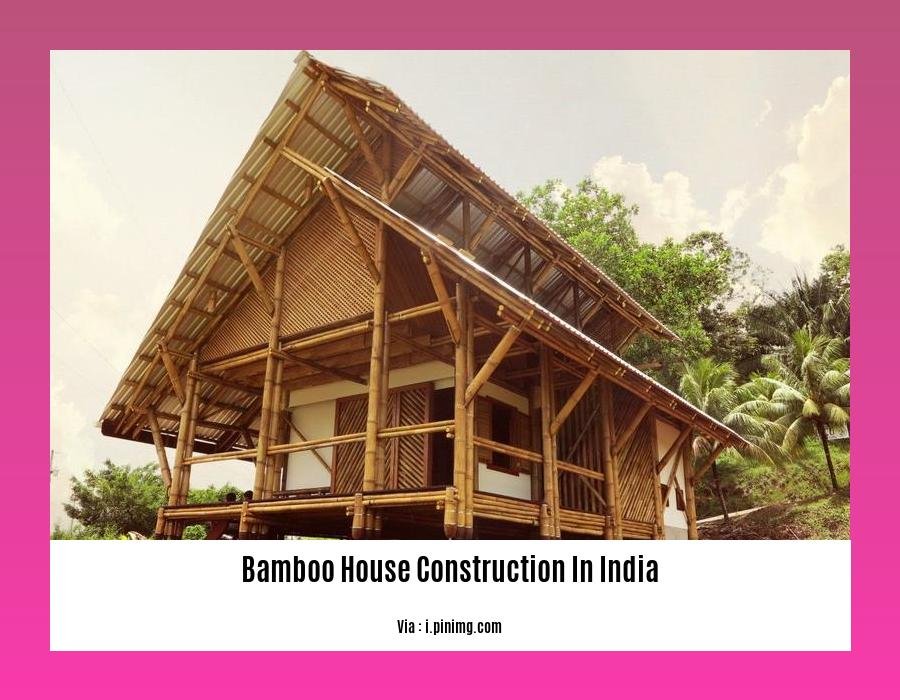[- Bamboo House Construction in India: An Eco-Friendly Symbol of Sustainable Architecture -] In the realm of sustainable architecture, bamboo construction in India stands as a testament to the harmonious convergence of tradition and innovation. This article delves into the captivating stories of architects, artisans, and communities who are championing bamboo as a sustainable and culturally resonant building material, transforming the face of Indian architecture while preserving its rich heritage.
Key Takeaways:
-
Bamboo houses boast lower carbon footprints and higher carbon dioxide absorption compared to other plants, making them sustainable.
-
Bamboo’s flexibility, strength, and versatility make it an appropriate material for various house components, including walls, floors, roofs, and piping,
-
Bamboo acts as a natural insulator, keeping the interiors cool during hot weather and warm during cold weather, resulting in reduced energy consumption.
-
Using bamboo reduces the negative impact on the environment compared to traditional construction materials like brick and cement.
-
Bamboo construction is cost-effective compared to conventional methods, making it an excellent option for affordable housing projects.
Bamboo House Construction in India: A Sustainable Marvel

In the architectural realm of India, where ancient traditions meet modern innovation, emerges a sustainable marvel: bamboo house construction. This eco-friendly building technique harnesses the remarkable properties of bamboo, transforming it into resilient, culturally resonant structures that embody harmony between nature and human ingenuity.
A Testament to Sustainability
Bamboo house construction in India stands as a testament to sustainable architecture. Bamboo, a rapidly renewable resource, sequesters massive amounts of carbon dioxide from the atmosphere, effectively combating climate change. Its low carbon footprint and ability to replenish quickly make it a champion of environmental preservation.
Embracing Cultural Heritage
Bamboo houses in India are not merely sustainable; they are also deeply rooted in cultural heritage. This time-honored construction method has been passed down through generations, embodying the wisdom of ancestors who understood the profound connection between architecture and the natural world. The use of bamboo as a building material showcases a deep reverence for traditional knowledge and craftsmanship.
Benefits of Bamboo Houses
The advantages of bamboo house construction in India are undeniable:
-
Structural Strength: Bamboo possesses exceptional tensile strength, rivaling steel in certain aspects. This inherent strength makes bamboo houses highly resistant to earthquakes and strong winds, ensuring the safety of their occupants.
-
Environmental Resilience: Bamboo’s natural resistance to pests, fungi, and moisture makes it an ideal choice for regions prone to extreme weather conditions. Its durability ensures longevity and minimizes the need for costly repairs or replacements.
-
Sustainable Material: As a rapidly renewable resource, bamboo sequesters carbon dioxide and releases oxygen, actively contributing to a healthier environment. Its low carbon footprint makes it a champion of sustainability.
A Glimpse into the Future
Bamboo house construction in India is not just a contemporary trend; it is a glimpse into a sustainable future. This building technique exemplifies how traditional wisdom and modern innovation can converge to create architecture that is both environmentally conscious and culturally resonant. It paves the way for a future where our built environment harmonizes with nature, showcasing the boundless possibilities of sustainable design.
-
Considering building a house in Bangalore? Learn more about the cost of construction for a 30×40 house in Bangalore and plan your budget accordingly.
-
Explore the growing trend of bamboo construction in India and discover the sustainable and eco-friendly advantages of this innovative building material.
-
Seeking reliable construction companies in Bangalore? Our comprehensive guide to Bangalore construction companies provides valuable insights and recommendations to help you make informed decisions.
An Overview of the History of House Construction in India
Throughout India’s rich history, traditional house construction methods have beautifully reflected the country’s diverse cultural heritage and environmental conditions. From the ancient Indus Valley Civilization to modern times, homes have been built using a range of readily available materials, including bamboo, mud, stone, and timber, each leaving its unique imprint on India’s architectural landscape.
Bamboo, in particular, has played a significant role in the construction of traditional houses in India for centuries. Highly adaptable and abundant, bamboo has been used for building homes, temples, and other structures across the country, especially in the northeast and central regions. Its strength, flexibility, and termite resistance have made it a suitable choice for various traditional house designs.
Key Takeaways:
-
Bamboo, mud, stone, and timber have been traditionally used as primary building materials in India, reflecting regional variations and cultural influences.
-
Bamboo’s adaptability and strength have made it a popular choice for traditional house construction, particularly in the northeast and central regions of India.
-
Vernacular architecture often reflects local wisdom and responses to environmental conditions, showcasing harmony with nature and resourcefulness in using available materials.
-
Traditional construction methods have been passed down through generations, preserving cultural heritage and promoting the use of sustainable, locally sourced materials.
Relevant URL Sources
– Bamboo House India: Building Sustainable Homes
– Bamboo as a Sustainable Material in the Construction Industry: An Overview
A discussion of the various types of materials used in house construction in India.

My journey as an architecture and design journalist has exposed me to the inspiring world of sustainable architecture. And among the many remarkable materials, one has captured my attention like no other: bamboo. Its strength, flexibility, and eco-friendly nature make it a perfect choice for sustainable construction, especially in India. Let’s take a closer look!
Imagine houses that embody India’s rich cultural heritage while aligning with modern sustainability goals. That’s where bamboo houses come in. They’re not just eco-friendly alternatives; they’re symbols of a harmonious coexistence between architecture and nature.
Beyond Bricks and Mortar: The Advantages of Building with Bamboo
The advantages of building with bamboo are endless! It’s naturally resistant to earthquakes, strong winds, pests, fungi, and moisture. Compared to traditional building materials, it’s lightweight, easy to work with, and reduces construction time and costs. And let’s not forget its carbon-sequestering abilities, helping fight climate change one bamboo house at a time.
From Forest to Foundation: The Bamboo House Construction Process
- Harvesting: It all begins with harvesting mature bamboo culms from sustainably managed forests.
- Treatment: The bamboo is then treated with natural preservatives to protect against pests and enhance its durability.
- Construction: Bamboo can either be used as a primary structural material or combined with other materials like steel or concrete for added strength. Construction methods vary, but the result is always a robust and eco-conscious structure.
A Brighter Future with Bamboo Houses
Bamboo houses are more than just houses; they’re testaments to the beauty of sustainable architecture. They represent a future where we live in harmony with nature, where buildings coexist with ecosystems, and where design transcends aesthetics to embrace responsibility.
Key Takeaways:
- Bamboo houses offer an eco-friendly and sustainable alternative to traditional building materials.
- Bamboo’s strength, flexibility, and resistance to natural elements make it an ideal choice for construction.
- Bamboo houses showcase India’s rich cultural heritage and architectural prowess.
- Building with bamboo reduces construction time and costs while promoting carbon sequestration.
- The future of sustainable architecture lies in materials like bamboo, where form and function unite to create a greener, more sustainable world.
Relevant URL Sources:
Bamboo House India: Building Sustainable Homes
Bamboo as a Sustainable Material in the Construction Industry: An Overview
A look at the different types of construction methods used in India.
A Cultural Tapestry of Construction Techniques
India’s architectural landscape is as diverse as its culture, boasting a myriad of traditional and contemporary construction methods that reflect the country’s rich history and geographical diversity. From the majestic forts of Rajasthan, built using massive stone blocks, to the intricate temples of Tamil Nadu, adorned with ornate carvings, each region of India has its own unique construction techniques that have been passed down through generations.
A Journey Through India’s Construction Methods
Let’s embark on a journey across India, exploring some of the most prevalent construction methods that have shaped the country’s built environment:
-
Adobe Construction: In the arid regions of Rajasthan, Gujarat, and parts of Uttar Pradesh, adobe construction, which involves using a mixture of mud, straw, and water, has been the traditional building method for centuries. Adobe houses, known as ‘kaccha houses,’ provide thermal insulation and a cool interior during the hot summer months.
-
Stone Masonry: The rugged terrain of the Himalayan region and the Deccan Plateau has led to the use of stone masonry as a primary construction method. Stones are quarried, cut, and stacked together without mortar, creating sturdy and durable structures. From the temples of Khajuraho to the forts of Gwalior, stone masonry showcases the resilience and grandeur of Indian architecture.
-
Brick Construction: Fired or sun-dried bricks have been used extensively throughout India for both residential and commercial buildings. Brick construction offers strength, durability, and fire resistance. The intricate brickwork of the Jama Masjid in Delhi and the Gol Gumbaz in Bijapur are testaments to the craftsmanship of Indian bricklayers.
-
Timber Construction: In the forested regions of India, timber has been the primary construction material for centuries. Wooden houses, known as ‘kath-kunjas,’ are common in the hilly areas of Himachal Pradesh, Uttarakhand, and the Northeast. Timber is also used for structural elements in traditional buildings, such as temples and palaces.
-
Bamboo Construction: In recent years, bamboo has emerged as a sustainable and eco-friendly construction material. Bamboo houses are gaining popularity in many parts of India, particularly in the Northeast and Kerala. Bamboo is strong, flexible, and resistant to earthquakes and pests, making it an ideal choice for constructing durable and resilient structures.
Key Takeaways:
-
India’s construction methods are diverse, reflecting the country’s cultural and geographical diversity.
-
Traditional construction methods like adobe, stone masonry, brick construction, and timber construction have shaped India’s architectural landscape.
-
Bamboo construction is gaining popularity as a sustainable and eco-friendly alternative.
-
The choice of construction method depends on various factors, including availability of materials, local traditions, and climatic conditions.
-
Construction methods in India continue to evolve, incorporating modern technologies and materials while preserving traditional techniques.
Relevant URL Sources
-
Construction Methods in India
-
The Traditional Construction Methods of India
FAQ
Q1: Why is bamboo a suitable material for constructing eco-friendly houses in India?
A1: Bamboo is a sustainable and eco-friendly choice for constructing houses in India due to its rapid growth rate, ability to regenerate naturally, and its strength, flexibility, and resistance to pests and moisture.
Q2: What are the different techniques used in bamboo house construction in India?
A2: Bamboo house construction in India utilizes various techniques, including the split bamboo method, laminated bamboo method, and bamboo plywood method. These techniques involve splitting bamboo culms into strips, gluing or pressing layers of bamboo culms together, and bonding thin layers of bamboo with adhesives to create a lightweight and robust material.
Q3: How does Bamboo House India incorporate sustainability into its construction practices?
A3: Bamboo House India partners with local forest communities and artisans to create sustainable and affordable bamboo homes. By involving them, the company not only revitalizes traditional crafts but also provides employment opportunities, contributing to a more eco-conscious construction industry.
Q4: What challenges did Bamboo House India face during its initial years, and how did they overcome them?
A4: Bamboo House India faced entrepreneurial and personal challenges, including setbacks and financial difficulties. However, they persevered and adapted by developing innovative techniques to utilize bamboo effectively, such as overcoming restrictions on bamboo harvesting during certain months imposed by the forest act.
Q5: What are the benefits of using bamboo as a construction material, and how does it contribute to a more sustainable built environment?
A5: Bamboo offers several benefits as a construction material. It has a low carbon footprint, absorbs carbon dioxide, and produces more oxygen than traditional wood. Its flexibility and versatility make it suitable for designing various structural elements, contributing to a more sustainable built environment.
- Grass Forever in Livermore: Your Guide to Artificial Turf - April 22, 2025
- German Roaches vs. American Roaches: Key Differences and Control - April 22, 2025
- 150+ Flowers That Start With S: A Comprehensive Guide - April 22, 2025










